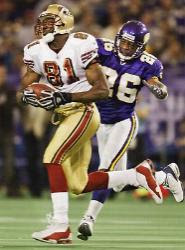
Marvin Harrison
TOP 10 RECEPTIONS
1- Marvin Harrison, 2002 Indianapolis Colts
143 rec., 1722 yards, 12.0 avg., 11 TD
2- Wes Welker, 2009 New England Patriots
123 rec., 1348 yards, 11.0 avg., 4 TD
3- Andre Johnson, 2008 Houston Texans
115 rec., 1575 yards, 13.7 avg., 8 TD
4- Rod Smith, 2001 Denver Broncos
113 rec., 1343 yards, 11.9 avg., 11 TD
5(tied)- Jimmy Smith, 2001 Jacksonville Jaguars
112 rec., 1373 yards, 12.3 avg., 8 TD
5(tied)- Hines Ward, 2002 Pittsburgh Steelers
112 rec., 1329 yards, 11.9 avg., 12 TD
5(tied)- T.J. Houshmandzadeh, 2007 Cincinnati Bengals
112 rec., 1143 yards, 10.2 avg., 12 TD
5(tied)- Wes Welker, 2007 New England Patriots
112 rec., 1175 yards, 10.5 avg., 8 TD
9- Wes Welker, 2008 New England Patriots
111 rec., 1165 yards, 10.5 avg., 3 TD
10-Marvin Harrison, 2001 Indianapolis Colts
109 rec., 1524 yards, 14.0 avg., 15 TD

Andre Johnson

Wes Welker
BEST BY FRANCHISES NOT IN TOP 10
Baltimore Ravens: Derrick Mason, 2007
103 rec., 1087 yards, 10.6 avg., 5 TD
Kansas City Chiefs: Tony Gonzalez, 2004
102 rec., 1258 yards, 12.3 avg., 7 TD
Buffalo Bills: Eric Moulds, 2002
100 rec., 1292 yards, 12.9 avg., 10 TD
San Diego Chargers: LaDainian Tomlinson, 2003*
100 rec., 725 yards, 7.3 avg., 4 TD
Tennessee Titans: Derrick Mason, 2004
96 rec., 1168 yards, 12.2 avg., 7 TD
Oakland Raiders: Jerry Rice, 2002
92 rec., 1211 yards, 13.2 avg., 7 TD
New York Jets: Laveranues Coles, 2006
91 rec., 1098 yards, 12.1 avg., 6 TD
Cleveland Browns: Kellen Winslow Jr., 2006
89 rec., 875 yards, 9.8 avg., 3 TD
Miami Dolphins: Chris Chambers, 2005
82 rec., 1118 yards, 13.6 avg., 11 TD
* Running Back

Hines Ward

Reggie Wayne
TOP 10 YARDS
1- Marvin Harrison, 2002 Indianapolis Colts
1722 yards, 143 rec., 12.0 avg., 11 TD
2- Rod Smith, 2000 Denver Broncos
1602 yards, 100 rec., 16.0 avg., 8 TD
3- Andre Johnson, 2008 Houston Texans
1575 yards, 115 rec., 13.7 avg., 8 TD
4- Andre Johnson, 2009 Houston Texans
1569 yards, 101 rec., 15.5 avg., 9 TD
5- Marvin Harrison, 2001 Indianapolis Colts
1524 yards, 109 rec., 14.0 avg., 15 TD
6- Reggie Wayne, 2007 Indianapolis Colts
1510 yards, 104 rec., 14.5 avg., 10 TD
7- Randy Moss, 2007 New England Patriots
1493 yards, 98 rec., 15.2 avg., 23 TD
8- Chad Johnson, 2007 Cincinnati Bengals*
1440 yards, 93 rec., 15.5 avg., 8 TD
9- Chad Johnson, 2005 Cincinnati Bengals*
1432 yards, 97 rec., 14.8 avg., 9 TD
10-Marvin Harrison, 2000 Indianapolis Colts
1413 yards, 102 rec., 13.9 avg., 14 TD
*Legally changed name to Chad Ochocinco in 2008

Randy Moss

Chad Ochocinco
BEST BY FRANCHISES NOT IN TOP 10
Kansas City Chiefs: Derrick Alexander, 2000
1391 yards, 78 rec., 17.8 avg., 10 TD
Jacksonville Jaguars: Jimmy Smith, 2001
1373 yards, 112 rec., 12.3 avg., 8 TD
Pittsburgh Steelers: Hines Ward, 2002
1329 yards, 112 rec., 11.9 avg., 12 TD
Buffalo Bills: Eric Moulds, 2000
1326 yards, 94 rec., 14.1 avg., 5 Td
Tennessee Titans: Derrick Mason, 2003
1303 yards, 95 rec., 13.7 avg., 8 TD
Cleveland Browns: Braylon Edwards, 2007
1289 yards, 80 rec., 16.1 avg., 16 TD
New York Jets: Laveranues Coles, 2002
1264 yards, 89 rec., 14.2 avg., 5 TD
Oakland Raiders: Jerry Rice, 2002
1211 yards, 92 rec., 13.2 avg., 7 TD
San Diego Chargers: Vincent Jackson, 2009
1167 yards, 68 rec., 17.2 avg., 9 TD
Miami Dolphins: Chris Chambers, 2005
1118 yards, 82 rec., 13.6 avg., 11 TD
Baltimore Ravens: Derrick Mason, 2007
1087 yards, 103 rec., 10.6 avg., 5 TD

Rod Smith

T.J. Houshmandzadeh









































